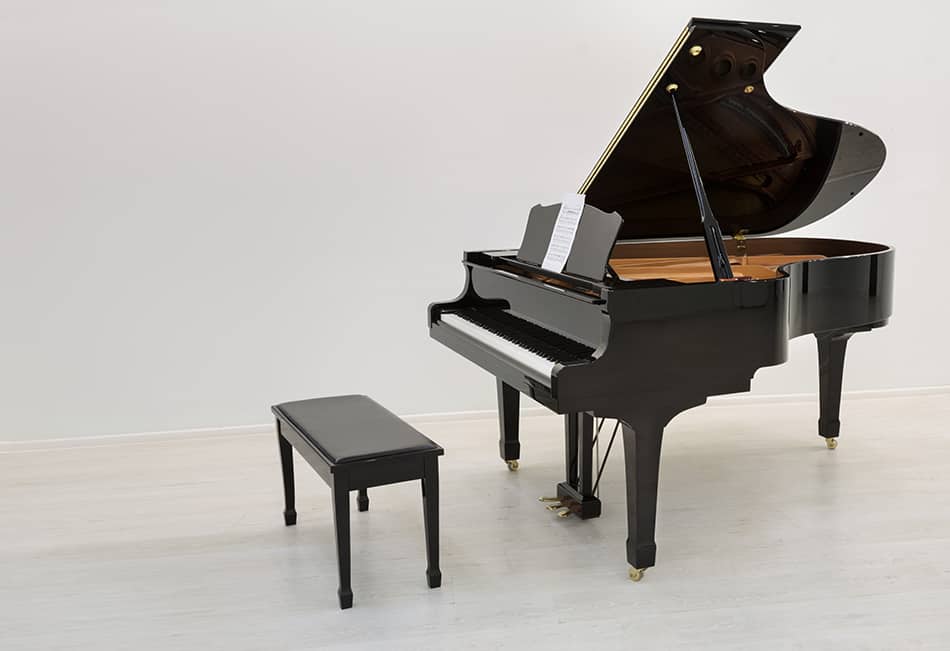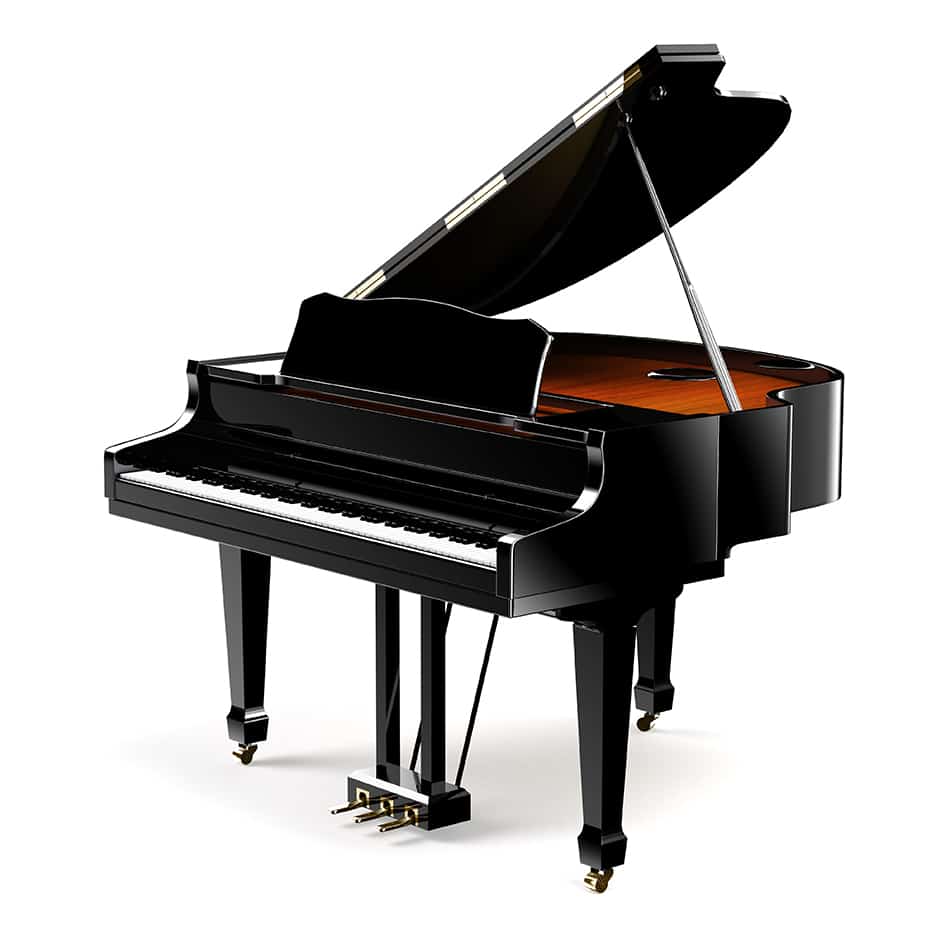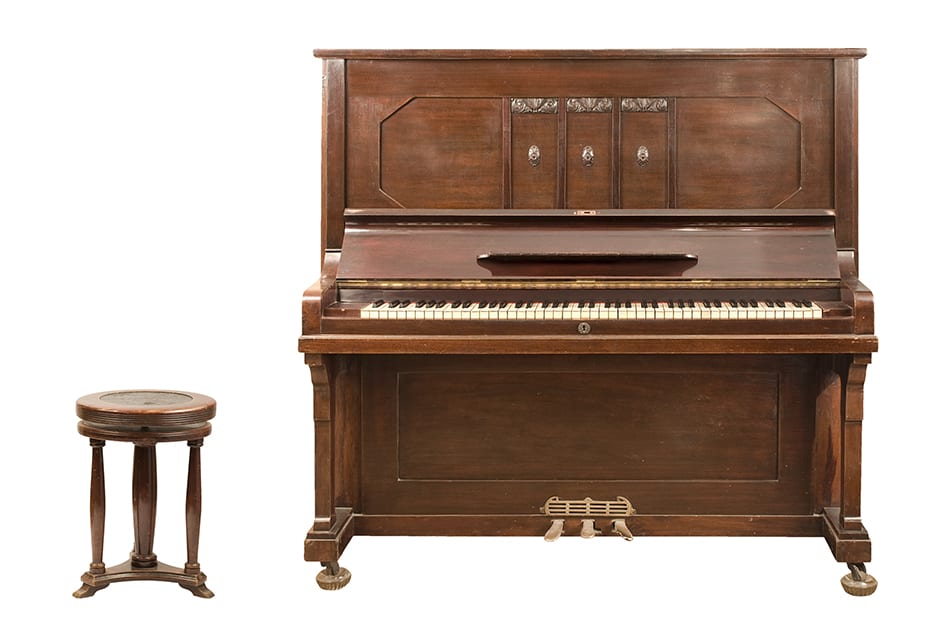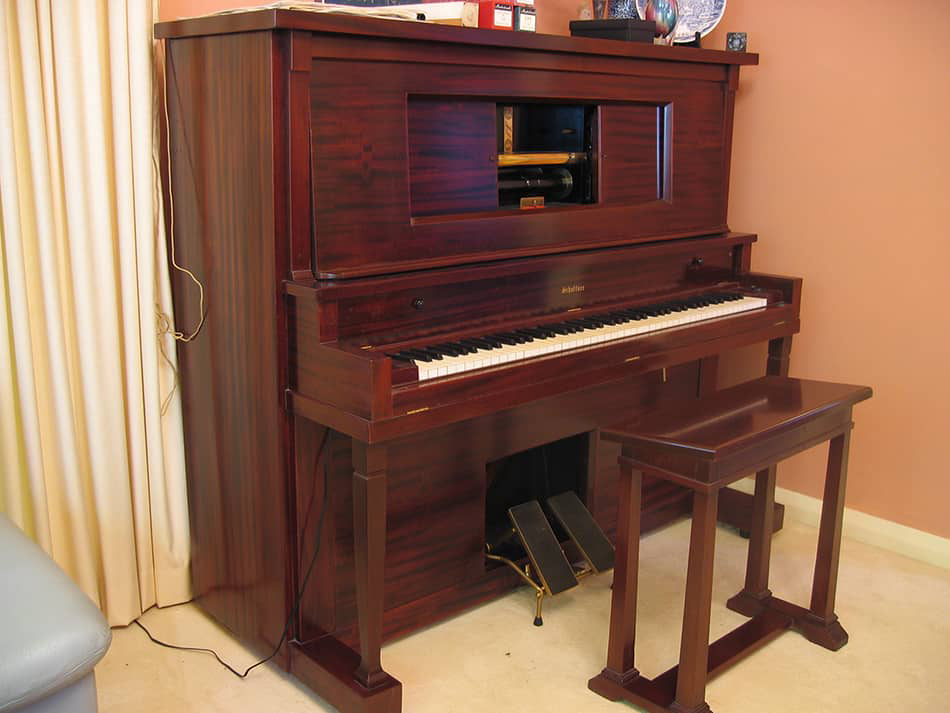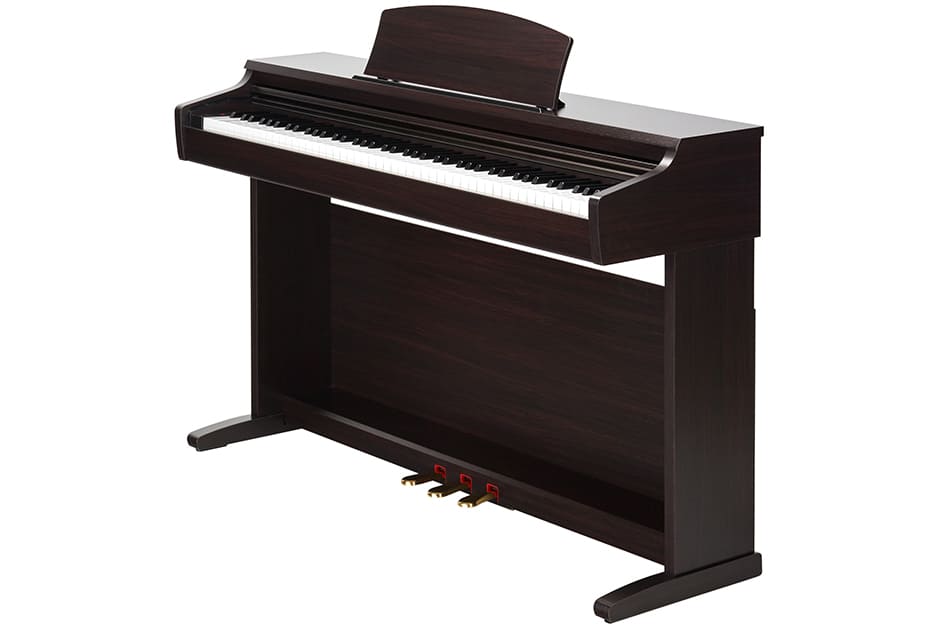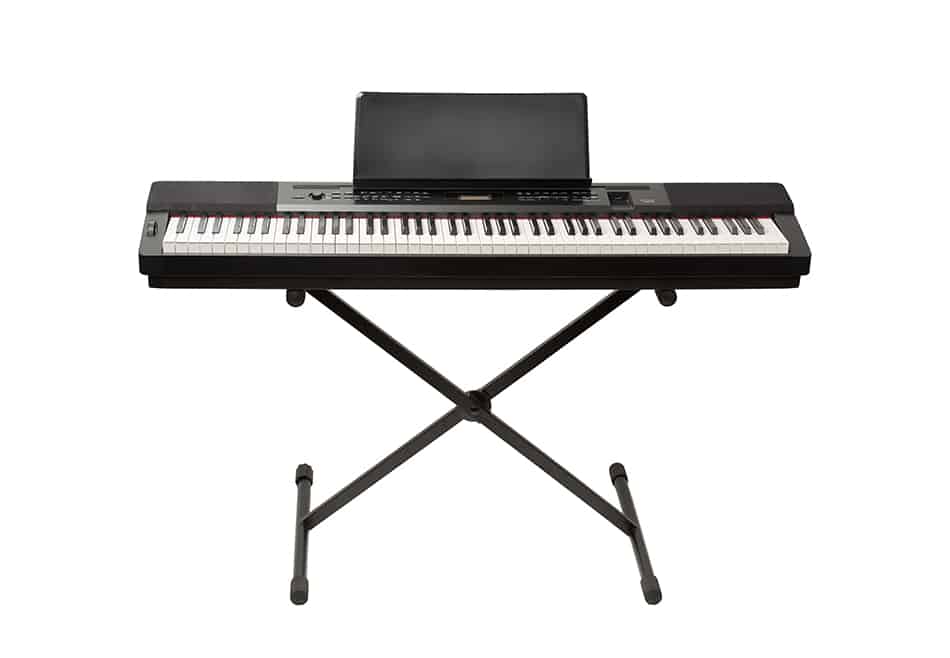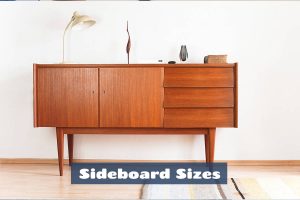A piano, or pianoforte in full, is a stringed percussion instrument invented by Italian Bartolomeo di Francesco Cristofori in the early 1700s. Other instruments, mainly the harpsichord and clavichord, existed and were popular at the time. Both were also stringed instruments played using a keyboard. The harpsichord’s strings produced music by being plucked with plectrums, and it sounds similar to a guitar.
The clavichord’s strings were struck by small metal hammers, but its sound was soft. The piano was a significant improvement over the harpsichord and clavichord because it can produce dynamic sounds of different strengths and volumes. This ultimately made the piano famous.
The earliest pianos had 60 keys, and over the next century and a half, they underwent a few changes as the needs of musical composers changed. By the 1880s, Steinway was producing pianos with 88 keys, which remains the standard today.
How Do Pianos Work?
There are some different types of pianos; however, most have the same major piano anatomy. A piano has 52 white keys, 36 black keys, and a 7-octave range. Each piano key is a lever that sets off a series of events inside the piano to produce the sound you hear. These events are known as the piano’s “action” or “mechanism.” The action involves some fairly sophisticated engineering and can be challenging to understand.
In a nutshell, when a piano key is pressed, it raises a hammer that strikes a tempered steel string from below, creating vibrations that resonate throughout the piano’s body and on its wooden soundboard.
The soundboard – known as the soul of a piano – acts as a speaker and amplifies the sound you hear. Located at the end of the key is a damper, which stops the string’s vibrations after a note has been played or ensures that it stays quiet when it is not in use.
Most modern pianos have three pedals, and each has an impact on the sound. The sustain pedal, also known as the damper pedal, is found on the right. It keeps a note going longer by stopping the dampers from silencing the string, even if the player is no longer pressing down on the key.
The pedal on the left is called the soft pedal. It softens a note without changing its tone. The soft pedal moves the hammer closer to the string on upright pianos, making the hammer’s strike gentler.
The sostenuto pedal performs a similar function to the sustain pedal. The difference is that, when pressed down, it maintains only the note that is being played at that moment. In other words, it silences the damper of only one string.
A piano can have as many as 236 strings because some keys require more than one string to produce a note. Each string can hold anything from 160 to 200 pounds of tension, so multiplied across the whole piano, the result is upwards of 35,000 pounds of tension encased in the instrument’s body. For this reason, a piano frame is constructed from cast metal and strong wood.
Depending on how much a piano is played, the strings will need retuning at least once a year. Pianos that are used a lot should be tuned every 3-6 months.
Finding the Right Piano
Whether you’re a beginner or a professional musician, the decision to buy a piano is a major one. A few of the things you should consider are how you’re planning to use the instrument (will you be playing it occasionally or daily?). What is your budget? How much space do you have in your home, school, or studio?
“Touch” refers to the effort it takes to play the piano and helps a player properly convey the tone of a piece of music.
Types of Pianos
Grand Pianos
Grand pianos are the original shape that pianos were created in, and just as their name suggests, they are large. They’re the crème de la crème pianos, loved by professional musicians, especially classical and jazz players. Grand pianos are usually the most expensive piano type you can find.
Grand pianos display the best in craftsmanship, with many of the world’s top piano manufacturers making them by hand. They’re made using high-quality woods like maple, spruce, and pine. It can take up to a year to produce one grand piano, depending on its size, materials used, and the time needed for the wood to season.
The large piano frame is usually made from a mix of iron and steel, contributing to the overall acoustic quality of the piano.
The signature curve of the grand piano is given by the rim or case, which plays a vital role in controlling the tone and volume of the piano’s sound as it’s played.
The rim is made from thin layers of wood glued together and laminated, then bent and held in place for three months or more to maintain its shape. Depending on the make and model of the piano, the rim will have anything from 5 to 20 layers. Once the rim has been formed, it is connected to straight beams inside the piano, called the inner rim, on which the soundboard rests.
The grand piano’s soundboard is made with the best wood. It’s positioned horizontally inside the piano’s body and tapers gently from its domed crown to its edges.
With their robust body, long strings, and big soundboard, grand pianos produce rich and deep sounds.
Grand pianos look even more majestic, and their sound is further amplified when their lid is raised.
What Makes Horizontal Grand Pianos Different?
Grand pianos play via a direct blow action, meaning that the hammer and strings sit directly above the full-length keys. When the key is struck, it dislodges the hammer from its resting position to play the note.
Once the note has been played, the hammer naturally returns to its resting position using gravity instead of other mechanical means. This gives grand pianos a moderate touch, making it possible to repeatedly strike the same key with quick, smooth, and controlled movement. This superior playing experience makes grand pianos highly prized among players.
Types of Grand Pianos
Some manufacturers sell grand pianos in as many as seven size classifications, but the most common are the Baby, Medium, Professional, and Concert Grands.
The Baby Grand is among the smallest and most affordable grand pianos. This entry-level model is suitable for use in homes, provided you have space. Baby Grands measure between 4 feet 6 inches and 5 feet 3 inches and weigh approximately 550 pounds.
Given the Medium Grand’s longer strings, they offer a fuller and louder sound than the Baby. But they are still affordable enough for private use in homes. Medium Grands measure 5 feet 5 to 6 feet 3 inches.
Professional Grands are the entry into the impressive grand pianos played in large venues. They range from 6 feet 5 to 7 feet 4 inches and weigh as much as 850 pounds.
Concert Grands are the biggest of all grand pianos. They’re the pianos played in symphony orchestras and in the world’s biggest venues. Concert Grands are over 9 feet long and weigh an immense 900 to 1200 pounds. These pianos also have a hefty price tag, with the models from top brands like Steinway and Bösendorfer costing $300,000 or more.
Upright Pianos
The upright piano was designed by John Isaac Hawkins in the early 1800s. The main advantage of uprights over grand pianos is that uprights take up far less space. They can conveniently be positioned flat against a wall, plus they are more affordable than grand pianos. Don’t let their lower price fool you, though.
Many of today’s best upright pianos are made with excellent materials. They are built to high standards and can deliver sound that rivals entry-level grand pianos.
What Makes an Upright Piano Different?
In an upright piano, the soundboard and strings are positioned vertically and are perpendicular to the keys. As in all pianos, when the keys are struck on an upright piano, they engage the hammers. But, instead of coming back to their resting position under their own weight, hammers in an upright rely on springs. Because of this, repeated keystrokes are slightly slower and not as smooth as they are in grand pianos.
Upright pianos are widely used in homes, schools, and studios. They are the pianos on which children often start to learn how to play. The various types of upright pianos are spinet, console, studio, and professional.
Types of Upright Piano
Spinet Upright Piano
At around 38 inches high, spinets were the smallest upright pianos. They were invented in the 1930s at the height of the Depression in response to people having less money and living in more cramped spaces.
Spinets have a small soundboard, so they don’t deliver the same quality and full sound as larger pianos. Because of its small size, the top of the spinet is just a few inches above the keys. So there isn’t enough room to fit the piano’s mechanism in the same way it would in a typical piano, and a unique adaptation had to be made.
As a result, the hammer and strings on a spinet sit below the keyboard, and the keys themselves are short. Because of this, a spinet’s key cannot engage the hammer directly. Instead, the hammer is moved to play the note by vertical wires and wooden rods. This is known as an indirect action. The feel of playing a spinet piano is different than when playing the piano with a standard direct action.
Due to the unusual and more complicated playing mechanism, a spinet’s tuning could be imprecise and only worsened as the piano aged. And when a spinet needed repairs, piano technicians found that it took more time and effort than it was really worth. For these reasons, spinets are no longer made today. However, they are still bought and sold in the second-hand market or handed down in families.
Spinets are generally not recommended for beginner piano students because their atypical action doesn’t develop the student’s hand strength and technical playing abilities to the same degree as better quality pianos.
Console Upright Piano
Often confused with a spinet piano, console pianos are compact but slightly taller, ranging between 40 to 43 inches high. Consoles also differ from spinets in that they have a typical direct action that sits above the keys, so the quality of its tuning is better than a spinet.
Consoles are considered decent pianos for hobby pianists. They are beginner-friendly instruments that deliver a pleasant playing experience that’s comfortable for learners.
There are two styles of consoles – furniture and continental. Furniture consoles have two legs under the keyboard and are designed according to popular furniture styles, such as Traditional, French Provincial, or Mid Century Modern. Continental consoles don’t have legs and feature a sleek and modern silhouette.
Studio Upright Piano
With a height of up to 48 inches, studio pianos are the crossover point from small uprights to larger sizes. Studio uprights feature a full-size action connecting directly to the keys. Therefore, they play more like horizontal pianos, with better key control and richer sound quality and tone due to their larger soundboard and longer strings.
Studio uprights also tend to be made with better quality materials, offering more durability and stability than spinets and some consoles. This is why you tend to find studio uprights in schools, churches, dance, or music studios. It’s an excellent piano for experienced musicians and composers.
Professional Upright Piano
The professional upright is the tallest of all upright pianos, at around 55 inches in height. Professional uprights are so large that they used to be called Upright Grands.
Fittingly, this upright piano is ideal for semi-professional or professional musicians who may not have space in their homes or studio to fit a horizontal piano. They deliver outstanding sound quality and a superb playing experience.
Player Piano
Credit to MxAesir
A player piano is essentially a piano that plays itself. The piano “reads” music etched on perforated paper or metallic rolls and played it back. Player pianos were popular in the early 1920s, but their sales peaked as electrically recorded music became better and radio took off.
After half a century, player pianos made a comeback in the ’80s, thanks to modern technology and piano enthusiasts who restored old player pianos. Current versions of player pianos are capable of recording and playing back music from digital sources. However, player pianos shouldn’t be confused with digital or electric pianos.
A player piano is an entirely acoustic instrument, complete with hammers and strings interacting to produce sound like upright and grand pianos. They simply feature a built-in electronic mechanism to control the pressing of the keys, mimicking the actions of your fingers. They can just as easily be played the usual way by disabling the controls.
Digital Piano
Digital pianos arrived on the scene in the late 70s and early 80s, coinciding with the rapid developments in computer technology. They are found in various sizes and can be designed in the horizontal or upright style.
Recall that when you play an acoustic piano, the sound produced depends on the force of the fingers striking the keys and, subsequently, the piano’s mechanism. A digital piano’s “mechanism” works differently. Digital pianos have no strings. When a key is pressed on a digital piano, the sound of each note is produced using piano samples or is generated electronically. The sound is then amplified by a speaker.
Digital pianos are not simply poor imitations of acoustic pianos. There are sophisticated and high-quality models made today that replicate the sound, look and feel of traditional pianos. Some designs even include a complete set of full-sized weighted keys to give players the classic touch of a grand piano.
They come with convenient extra features too. You can connect headphones to a digital piano so you can play silently without bothering the neighbors. The piano can also be connected to a computer to record and edit music or digitally add other instruments.
Depending on the model you choose, another advantage of a digital piano over an upright or grand piano is its compact size and lighter weight. A digital piano sometimes comprises a keyboard and stand. Although some higher-end models have natural or faux wood stands that look more like a console piano for a more elegant look.
Digital pianos also don’t require as much thought in terms of their placement in your home. If the only spot you have available is close to a radiator or fireplace, you can put your digital piano there without worrying about a soundboard becoming dry and cracking.
Additionally, the lack of strings means you can do away with annual appointments with the piano tuner, so you save on those costs too. If you’re on a tight budget, a digital piano can be an affordable and accessible choice.
Electric Keyboards
Electric keyboards are modified pianos. A vital element of an electric keyboard is that it’s designed to be light and portable. They emulate the sounds of a piano, plus they include the sounds and tones of other instruments.
They have fewer keys than a standard piano, too – usually 61 or 76. An electric keyboard is more suited to a player looking for a fun instrument to enjoy and experiment with. It would not be considered suitable for the aspiring classic pianist.
